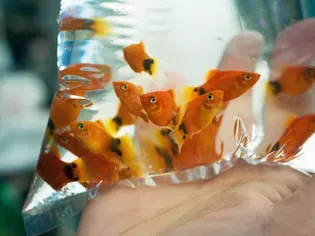How to Acclimate New Aquarium Fish to Your Home Aquarium
Updated on 04/26/24

Aquarium Acclimatization: A Comprehensive Guide for a Healthy and Thriving Underwater Environment
Introducing new inhabitants to your aquarium can be an exciting experience, but it's crucial to ensure their smooth transition into their new home. Acclimatization is the process of gradually adjusting the water parameters and environment to minimize stress and potential health issues for your finny friends. This comprehensive guide will equip you with all the knowledge and techniques you need to successfully acclimate your new aquarium fish.
Understanding the Importance of Acclimatization
* Reduces stress: Sudden changes in water temperature, pH, and other parameters can be highly stressful for fish, leading to weakened immune systems and increased susceptibility to diseases.
* Prevents shock: Rapid changes in water chemistry can cause osmotic shock, where fish's cells become damaged due to sudden changes in water concentration.
* Improves survival rates: Proper acclimatization significantly increases the chances of new fish adapting to their new environment and thriving in the long run.
Step-by-Step Acclimatization Procedure
1. Float the Bag:
* Allow the sealed bag containing the fish to float in the aquarium for about 15-30 minutes. This allows the water temperatures to equalize gradually.
2. Open the Bag and Add Aquarium Water:
* Carefully open the bag and add about 1 cup of aquarium water every 5-10 minutes for the next hour. This helps adjust the pH and other water parameters slowly.
3. Release the Fish:
* After about an hour, use a net to gently transfer the fish into the aquarium. Avoid pouring the bag water directly into the tank, as it may contain harmful substances.
4. Monitor the Fish:
* Keep an eye on the fish for the next few hours to ensure they are adjusting well. Look out for any signs of stress, such as erratic swimming, gasping for air, or hiding.
Specific Acclimatization Techniques for Different Species
* Tetras and Barbs: These hardy fish typically require minimal acclimatization and can be released into the aquarium after floating the bag for 15-30 minutes.
* Betta Fish: Bettas are more sensitive to water changes and require a gradual acclimatization process. Float the bag for at least 30 minutes and add aquarium water slowly over the next 2-3 hours.
* Marine Fish: Marine fish have unique acclimatization needs due to their specific salinity requirements. Use a hydrometer to measure the salinity of both the bag water and the aquarium water. Gradually adjust the salinity by adding small amounts of aquarium water to the bag over several hours.
Additional Tips for Successful Acclimatization
* Use a drip acclimator: This device allows for a gradual and controlled release of aquarium water into the bag, minimizing stress on the fish.
* Match water temperature: Ensure the temperature of the bag water and the aquarium water are within a few degrees of each other before beginning acclimatization.
* Avoid chlorine and chloramine: Use a water conditioner to remove any chlorine or chloramine present in the aquarium water, as these chemicals can be toxic to fish.
* Quarantine new fish: Keep new fish in a separate quarantine tank for at least 2-4 weeks to observe for any potential illnesses or parasites.
Conclusion
Acclimatizing new aquarium fish is an essential step for their well-being and long-term health. By following these comprehensive guidelines, you can ensure a smooth and successful transition for your new finned companions into their vibrant underwater home. Remember, patience and proper techniques are key to creating a thriving aquarium ecosystem where both your fish and you can enjoy the beauty and tranquility of the aquatic world.
Explore More Pets

Freshwater Aquarium Filters
How to Deal With Cloudy Aquarium Water

Saltwater Aquarium Filters
How Do You Remove Chloramines From Tap Water?

Freshwater Aquariums & Habitat
Can I Keep My Koi Fish Inside?

Saltwater Aquariums & Habitat
14 Best Floating Plants for Your Aquarium

Freshwater Fish Health
How to Treat Ich on Freshwater Fish

Saltwater Fish Health
Fin Rot in Aquarium Fish

Freshwater Aquarium Filters
How to Do Aquarium Water Changes

Saltwater Fish Health
How Do Fish Get Parasites?